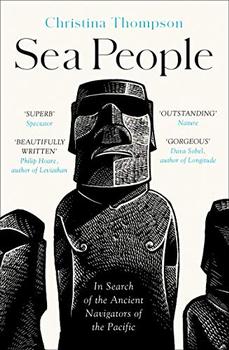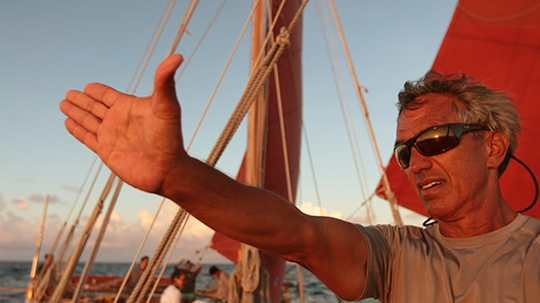Summary | Excerpt | Reviews | Beyond the Book | Read-Alikes | Genres & Themes | Author Bio

The Puzzle of Polynesia
by Christina ThompsonThis article relates to Sea People
 Although Sea People is largely written as a history focusing on Polynesia and its earliest inhabitants, it also introduces readers to the islands as a whole: the culture of the Polynesian people, the botany and wildlife of the many islands and the adventurous spirit of a people who loved exploration. This adventurous spirit, however, was lost during the Long Pause, a period of almost two millennia during which voyaging out and settling new Polynesian islands was halted for reasons still unknown. It wasn't until the 1960s that a group of Hawaiians began to dream of returning to their ancestral legacy of voyaging, and the Polynesian history of exploration was revived. One of the men who was integral to rebuilding this legacy was Nainoa Thompson.
Although Sea People is largely written as a history focusing on Polynesia and its earliest inhabitants, it also introduces readers to the islands as a whole: the culture of the Polynesian people, the botany and wildlife of the many islands and the adventurous spirit of a people who loved exploration. This adventurous spirit, however, was lost during the Long Pause, a period of almost two millennia during which voyaging out and settling new Polynesian islands was halted for reasons still unknown. It wasn't until the 1960s that a group of Hawaiians began to dream of returning to their ancestral legacy of voyaging, and the Polynesian history of exploration was revived. One of the men who was integral to rebuilding this legacy was Nainoa Thompson.
Nainoa Thompson was born in 1953 on the island of Oahu, Hawaii. From a young age, Nainoa spent time on the ocean, learning to be comfortable among the wind and waves, but when he began working at the Hui Nalu Canoe Club, his interest in the ocean became a passion. Across the canal from the Canoe Club lived Herb Kāne, a Hawaiian artist who dreamed of voyaging like his Polynesian ancestors. At the time, Kāne was working with a group of men to design Hokule'a ("Star of Gladness"), a replica of an ancient double-hulled voyaging canoe, and making plans to sail the vessel from Hawaii to Tahiti using traditional techniques.
 Nainoa was fascinated with the idea, and he earned a spot on the return crew for Hokule'a's maiden voyage in 1976; however, quarreling among the crew during the long trip from Hawaii to Tahiti alienated the ship's navigator, Mau Piailug. Mau was a master navigator from the Polynesian island of Satawal, capable of using the sun, wind, waves and stars to navigate across the ocean. At the time, Mau was one of the last people on Earth with knowledge of these wayfinding techniques. Although Mau successfully navigated Hokule'a to Tahiti, the unrest of the crew disappointed him, and he refused to make any further trips.
Nainoa was fascinated with the idea, and he earned a spot on the return crew for Hokule'a's maiden voyage in 1976; however, quarreling among the crew during the long trip from Hawaii to Tahiti alienated the ship's navigator, Mau Piailug. Mau was a master navigator from the Polynesian island of Satawal, capable of using the sun, wind, waves and stars to navigate across the ocean. At the time, Mau was one of the last people on Earth with knowledge of these wayfinding techniques. Although Mau successfully navigated Hokule'a to Tahiti, the unrest of the crew disappointed him, and he refused to make any further trips.
In stepped Nainoa, who was interested in wayfinding, but had little knowledge of the methods. Nainoa initially began researching wayfinding in order to better understand its importance to his ancestors, but he soon developed an extensive knowledge that made him the ideal choice as navigator for future voyages. After a failed attempt in 1978, however, Nainoa realized that relying solely on math and science wasn't enough, and he sought out Mau Piailug to serve as his teacher. Mau agreed, and the two began to go out in a canoe every day for Nainoa to study wayfinding firsthand, leading him to update the techniques for the modern age.
Modern wayfinding is a blend of traditional navigation techniques and contemporary scientific knowledge, like precise distance measuring and an understanding of weather patterns. Nainoa's form of wayfinding incorporates three main components: designing a course strategy, holding the course, and finding land. Designing a course for the voyage requires the navigator to use all the known components—wind patterns, ocean currents, distances, the canoe's capabilities and the seasons—to create a map for the voyage. However, unexpected issues may arise, and the navigator must be able to hold to the course they've designed. This involves using known navigational indicators such as the stars of the Southern Cross, the position of the sun, and the direction of the wind and waves, as well as oceanic landmarks to determine the canoe's location. In designing a course strategy, a navigator doesn't necessarily set a course directly for the final destination; rather, they aim for a "screen"—a group of islands that stretches out on either side of the destination—and landing anywhere within that screen will provide enough information to properly orient the navigator to their target.
In the spring of 1980, Nainoa used this combination of modern and traditional wayfinding techniques to plan another voyage, and Hokule'a set sail for Tahiti once again. The successful voyage made Nainoa the first native Hawaiian in modern times to navigate using some of the ancient techniques over that distance, and the return trip made him the first person to use wayfinding to navigate from Tahiti to Hawaii in over 600 years. The achievement sparked a renewed interested in ancient Polynesian culture and voyaging, one that was embraced by the Polynesian Voyaging Society (which owns Hokule'a and a second canoe called Hikianalia) and continues to this day.
Nainoa has since continued his work as a wayfinder, navigating Hokule'a throughout Polynesia on the 1985-1987 Voyage of Rediscovery, and the 2014-2017 Mālama Honua Worldwide Voyage. In 2007, he participated in pwo, a sacred initiation ritual that signifies mastery of deep sea navigation. Today, he is the president of the Polynesian Voyaging Society. Although Nainoa initially relied heavily upon his knowledge of math and science to help him navigate the ocean, he now says he has learned to rely more upon his instincts, allowing him to navigate as the ancients did. As he continues to share his knowledge of wayfinding with a new generation, he hopes that his work will help the people of Polynesia and the world connect more deeply with the ocean and better understand its importance to many cultures.
Nainoa Thompson, courtesy of The Explorers Club
Hokule'a, courtesy of Polynesian Voyaging Society
Filed under Cultural Curiosities
![]() This article relates to Sea People.
It first ran in the April 3, 2019
issue of BookBrowse Recommends.
This article relates to Sea People.
It first ran in the April 3, 2019
issue of BookBrowse Recommends.






Your guide toexceptional books
BookBrowse seeks out and recommends the best in contemporary fiction and nonfiction—books that not only engage and entertain but also deepen our understanding of ourselves and the world around us.